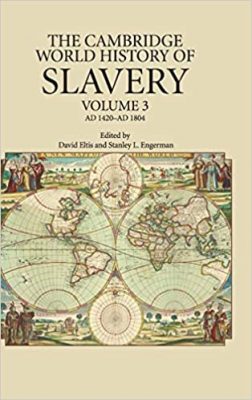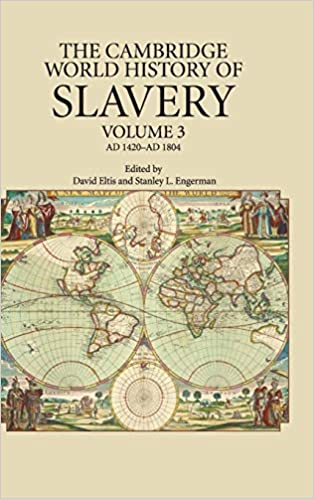 Volume 1 – The Ancient Mediterranean World – 620 pages
Volume 1 – The Ancient Mediterranean World – 620 pages
Editors: Keith Bradley and Paul Cartledge
Volume 3 – AD 1420 to 1804 AD – 762 pages
Editors: David Eltis and Stanley L. Engerman
Volume 4 – 1804 AD to 2016 AD – 705 pages
Editors: David Eltis and Stanley L. Engerman, Seymour Drescher, and David Richardson
Publisher: Cambridge University Press – Total 2,087 pages in 3 volumes
Book Review by: Sonu Chandiram
The Cambridge World History of Slavery spans around two millennia (2,000 years) from the first century up to the year 2016. Only three of four volumes of this Cambridge World History of Slavery were made available to us for review. Volume 2 was not available. Nevertheless, not only does this three-volume book cover about two thousand years, its total length is over two thousand pages.
In order to provide you our readers a brief overview of what is covered and discussed in this monumental work, we’ve enumerated below the titles of the 77 chapters in its three volumes.
Volume 1 – The Ancient Mediterranean World – 620 Pages
Editors: Keith Bradley and Paul Cartledge
- Slavery in the ancient Near East
- Slaves in Greek literary culture
- Classical Athens
- The Helots: a contemporary review
- Slavery and economy in the Greek world
- The slave supply in classical Greece
- Slavery and the Greek family
- Resistance among chattel slaves in the classical Greek world
- Archaeology and Greek slavery
- Slavery in the Hellenistic world
- Slavery and Roman literary culture
- Slavery in the Roman Republic
- Slavery under the Principate
- The Roman slave supply
- Slave labor and Roman society
- Slavery and the Roman family
- Resisting slavery at Rome
- Slavery and Roman material culture
- Slavery and Roman law
- Slavery and the Jews
- Slavery and the rise of Christianity
- Slavery in the late Roman world
While slavery may have begun among pre-historic humans, slavery as recorded by historians began as early as the first century AD (after the death of Jesus Christ), according to the editors of the first volume entitled The Ancient Mediterranean World. “It begins with an overview of slavery in the ancient Near East,” its editors Keith Bradley and Paul Cartledge write in their Introduction.
They then move on quickly to the societies of ancient Greece and Rome, where “slaves were regularly used as primary producers in the key economic activities of agriculture, mining, and manufacturing.” Besides laboring for their masters to create the products that were sold to generate wealth, the slaves also eased the burdens of their masters in their homes by acting as domestic servants.
A lot of topics are the subjects of discourse in the 22 chapters of this first volume as shown above. We are not going to get into the details of those topics and subjects in this combined book review of three volumes, leaving it to you our readers to get copies of these books to delve into them at any depth or detail you want to.
Volume 3 – 1420 AD to 1804 AD – 762 Pages
Editors: David Eltis and Stanley L. Engerman
- Dependence, Servility, and Coerced Labor in Time and Space
- Part I – Slavery in Africa and Asia Minor
- Enslavement in the Ottoman Empire in the Early Modern World
- Slavery in Islamic Africa, 1400 – 1800
- Slavery in Non-Islamic West Africa, 1420 – 1820
- Slaving and resistance to Slaving in West Central Africa
- White Servitude
- Part II – Slavery in Asia
- Slavery in Southeast Asia, 1420-1800
- Slavery in Early Modern China
- Part III – Slavery Among the Indigenous Americans
- Slavery in Indigenous North America
- Indigenous Slavery in South America, 1492-1820
- Part IV – Slavery and Serfdom in Eastern Europe
- Russian Slavery and Serfdom, 1450-1804
- Monorialism and Rural Subjection in East Central Europe, 1500-1800
- Part V – Slavery in the Americas
- Slavery in the Atlantic Islands and the Early Modern Spanish Atlantic World
- Slavery and Politics in Colonial Portuguese America: The Sixteen to the Eighteenth Centuries
- Slavery in the British Caribbean
- Slavery in the North American Mainland Colonies
- Slavery in the French Caribbean, 1635-1804
- Slavery and the Slave Trade of the Minor Atlantic Powers
- Part VI – Cultural and Demographic Patterns in the Americas
- Demography and Family Structures
- The Concept of Creolization
- Black Women in the Early Americas
- Part VII – Legal Structures, economics, and the Movement of Coerced Peoples in the Atlantic World
- Involuntary Migration in the Early Modern World, 1500-1800
- Slavery, Freedom, and the Law in the Atlantic World, 1420-1807
- European Forced Labor in the Early Modern Era
- Transatlantic Slavery and Economic Development in the Atlantic World: West Africa, 1450-1850
- Part VIII – Slavery and Resistance
- Slave Worker Rebellions and Revolution in the Americas
- Runaways and Quilombolas in the Americas
Volume 3 is essentially a collection of essays written by its editors and chapter authors that explore the numerous and various means of coerced labor that existed in the countries in the continents of Africa, Asia, North and South America from the fifteenth to the nineteenth centuries. The prevailing demographics, economics, gender, law, migration, race, and other factors led to outcomes – negative or positive – in these nations.
Volume 4 – 1804 AD to 2016 AD – 705 Pages
Editors: David Eltis, Stanley L. Engerman, Seymour Drescher, and David Richardson
- Part I – Overview
- Introduction
- Demographic Trends
- Overseas Movements
- Part II – Slavery
- The Non-Hispanic West Indies
- Slavery in Cuba and Puerto Rico, 1804 to Abolition
- Slavery in Nineteenth-Century Brazil
- US Slavery and Its Aftermath, 1804-2000
- Slavery in Africa, 1804-1936
- Ottoman Slavery and Abolition in the Nineteenth Century
- Slavery and Bondage in the Indian Ocean World, Nineteenth and Twentieth Centuries
- Slavery in India
- Slave Resistance
- Black Cultural Production in the Nineteenth Century
- Part III – Abolition
- Slavery and the Haitian revolution
- Slavery and Abolition in Islamic Africa, 1776-1905
- European Antislavery: From Empires of Slavery to Global Prohibition
- Antislavery and Abolitionism in the United States, 1776-1870
- The Emancipation of the Serfs in Europe
- British Abolitionism from the vantage of Pre-Colonial South Asian Regimes
- The Transition from Slavery to Freedom in the Americas after 1804
- Abolition and Its Aftermath in Brazil
- Part IV – Aftermath
- The American Civil War and Its Aftermath
- Dependency and Coercion in East Asian Labor, 1800-1949
- Gender and Coerced Labor
- Coerced Labor in Twentieth-Century Africa
- Indenture in the Long Nineteenth Century
- Forced Labor in Nazi Germany and the Stalinist Soviet Union
- Contemporary Coercive Labor Practices – Slavery Today
Volume 4 covers a lot of ground, as you can see from the range of subjects discussed in the titles of its 28 chapters. Numerous and varied events occurred during these 200-plus years in different parts of the world – in the many countries and regions all over the globe.
In this final volume, its four editors make these important points about slavery in the Introduction:
“Slavery has appeared in many different forms and is not always easy to separate from other forms of coerced labor. Nonetheless, there are basic similarities that emerge from the contributions that follow. Most critical of these is the ownership of one human by another and the ability to buy and sell the human chattel such ownership creates. A second common characteristic is the fact that chattel status is an inheritable condition passed down through the mother.”
This is truly an eye-opening and insightful book. What makes it a very valuable one? It is based on research gathered by numerous editors and contributors.







